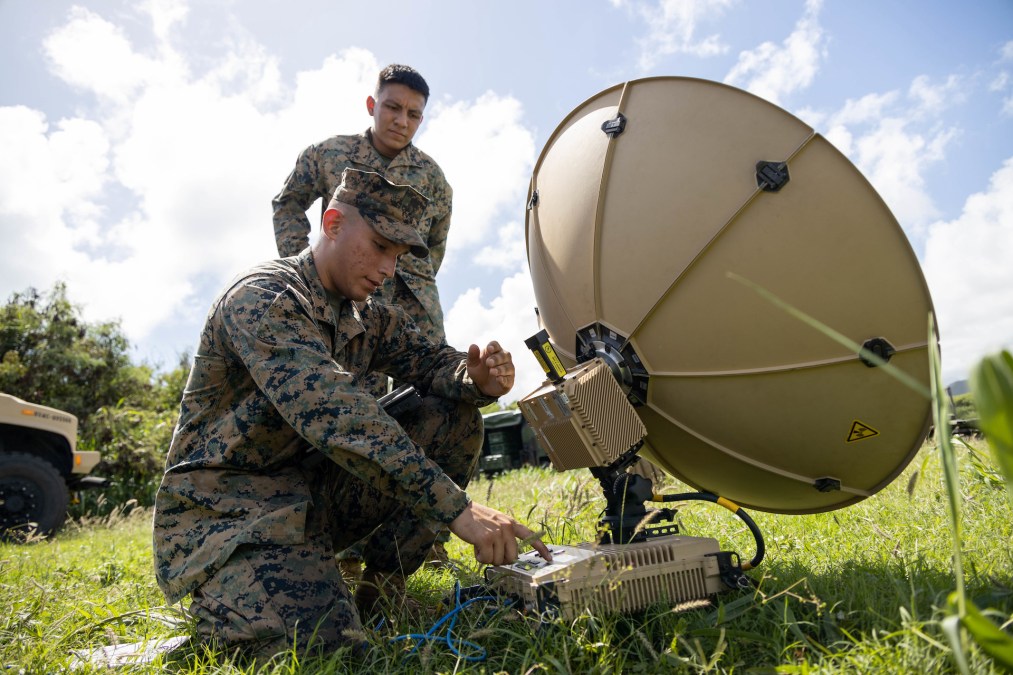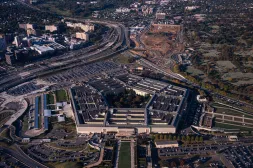Marine commandant’s new planning guidance emphasizes C2 investments

New planning guidance from the Marine Corps’ top officer puts a premium on modernizing the service’s command-and-control capabilities to create more lethal “kill webs” for the joint force.
The directive from Commandant Gen. Eric Smith, provided to reporters ahead of its official release, highlights the key roles that Marine expeditionary units would be expected to fill in potential future fights against China in the Indo-Pacific.
“My observations over the last year reinforce my belief that command and control, as well as our ability to share data, will play an outsized role in future conflict, especially in realizing distributed concepts such as the Stand-in Forces and Expeditionary Advanced Base Operations (EABO),” he wrote.
“Future large-scale combat operations will require a fully resourced and modernized Command Element at the MEF and intermediate headquarters (e.g., MEB, Division, Logistics Group, and Air Wing), capable of seamlessly aggregating and disseminating high-fidelity targeting information, coordinating multi-domain effects in support of maneuver, and synchronizing distributed operations into concentrated combined arms effects. Sensors and C2 capabilities across intermediate headquarters are similarly critical to enable Joint and Coalition C2 and kill webs — we must continue to invest in their proliferation,” he added.
Among the Corps’ expeditionary units, III MEF is expected to play a leading role for the service in competing with the Chinese military, Smith noted, calling it the “main effort” in campaigns to counter Beijing.
III MEF must be ready to serve as a so-called stand-in force for U.S. Indo-Pacific Command and the Navy’s Pacific Fleet that can get inside adversaries’ weapons engagement zones and provide sensing, long-range fires and other capabilities to “set the conditions” that will enable other elements of the joint force to accomplish their objectives.
As an analogy to illustrate his vision, Smith compared the III MEF to joint terminal air controllers (JTAC) that help other personnel locate and attack targets.
“These Marines will act as the ‘JTAC of the Joint Force’ – sensing, making sense, and communicating to the rest of the Joint Force with an ‘any sensor, any shooter’ mindset. The unique capabilities contained within the [Marine Air-Ground Task Forces] paired with the special operations capabilities of our Raiders forms a modernized warfighting capability with the agility and lethality capable of gaining and maintaining advantage from inside” the enemy’s weapons engagement zone, he wrote.
Smith’s planning guidance is in line with the Pentagon’s broader vision for Combined Joint All-Domain Command and Control (CJADC2), a warfighting construct that aims to better connect the sensors, shooters and data streams of the U.S. military services and key partners and allies under a more unified network to enable more efficient and effective operations.
One of the main lines of effort for critical capability development and investments outlined in the new document from Smith is enabling joint and coalition C2 and “kill webs.”
“We will continue to invest in capabilities and refine tactics that allow us to act as the forward element of the Joint Force — sensing, making sense, and communicating that information to any shooter. We will continue to pursue smaller form factor C2 nodes, field expeditionary ICD-705 compliant shelters capable of providing access to higher levels of classification at the tactical level, and leverage advances in artificial intelligence to enhance decision making at the tactical edge. Our Cyber Marines are already creating tremendous effects in the cyber domain — they will play a critical role in any future conflict,” he wrote.
Marine expeditionary units must put additional focus on CJADC2 to fully integrate the sensing capabilities of amphibious-ready groups, he noted.
The service’s vessels could serve as a launching pad for robotic systems that perform intelligence, surveillance, reconnaissance, strike or other missions, he suggested.
Some of the drones, unmanned subsurface vehicles and uncrewed surface vessels being pursued by other elements of the joint force are “a perfect match for our well decks and flight decks,” according to Smith.
Autonomous systems are also seen as a means of resupplying U.S. troops in dangerous areas where logistics will be contested by adversaries armed with advanced weapons and minimizing the number of service members that have to be put into harm’s way to accomplish those tasks.
The Corps is looking to continue experimenting with and investing in drones, counter-drone systems and other warfighting tools as it draws lessons from ongoing conflicts in Ukraine and the Middle East.
“Lessons observed in both the Black and Red Seas have re-emphasized the effectiveness of land-based precision fires in effecting sea denial. Moreover, we have seen cheap, long-range one-way drones used to great effect in imposing a steep cost in both conflicts. We will continue to invest in these capabilities as they are not only our most effective deterrent in the vastness of the Pacific, but also the best way to levy an outsized cost on any adversary we face. We will continue to experiment with our Long-Range Missile Battery while also pursuing a smaller form factor capability in-line with our expeditionary nature,” Smith wrote.
The commandant says Marines need to be ready to go into combat with emerging tech and other tools that might not have played a big role in previous conflicts.
“In the future, we will fight with prototypes. Battlefields throughout history demonstrate this fact, from the first usage of a tank in combat to the current employment of first-person-view drones in Ukraine,” Smith stated. “We must build agility into our acquisition processes to increase the velocity of fielding key capabilities as we identify them.”






